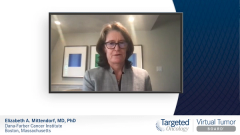
Metastatic TNBC Case Overview
Hope Rugo, MD, discusses the case of a 49-year-old woman diagnosed with metastatic triple-negative breast cancer.
Episodes in this series

Hope Rugo, MD: Hello, I’m Hope Rugo, a professor of medicine and the director of breast oncology and clinical trials education at the University of California San Francisco’s Comprehensive Cancer Center. It’s a pleasure to be here with you to talk through a case of an unfortunate young woman with triple-negative breast cancer that becomes metastatic. This patient initially presented at the age of 42 with a locally advanced right breast cancer and palpable axillary lymph nodes. The stereotactic core biopsy showed a grade 3 triple-negative breast cancer that was highly proliferative.
On examination, she had a large mass with dimpling of the areola, and at 12 o’clock, she had multiple palpable axillary nodes. She had an MRI of the breast, which confirmed a single mass that was locally advanced and showed that there were no tumors in her left breast. She had genetic testing, which is our current standard, including BRCA1 and BRCA2, which showed no evidence of germline mutations. She had staging with a PET [positron emission tomography]/CT scan that showed the mass in her right breast that was FDG [fluorodeoxyglucose] avid, and FDG-avid right axillary lymph nodes but no other site of disease. She was healthy without any other medical problems.
It was recommended to this patient that she receive neoadjuvant chemotherapy. She received weekly paclitaxel and carboplatin for 12 weeks followed by dose-dense doxorubicin and cyclophosphamide with an excellent clinical response on exam, with the exception of a persistent palpable axillary node. She then underwent right mastectomy because of the involvement of the areola and the skin dimpling, with axillary node sampling and immediate reconstruction. This showed 2 mm of residual disease in the breast that was not cellular. Unfortunately, 1 of 10 nodes was positive for residual invasive triple-negative breast cancer with evidence of extranodal extension. She then received postmastectomy radiation followed by 8 cycles of adjuvant capecitabine.
Subsequently, she felt well for about 13 months. She then presented with abdominal bloating, early satiety, a new cough, and worsening fatigue. A CT scan of the chest, abdomen, and pelvis revealed 2 nodules in the right lung, each measuring about 1.5 cm; pleural nodularity; several liver metastases up to 2 cm; and moderate hepatomegaly. Laboratory studies were normal, including liver enzymes. She had a liver biopsy that confirmed metastatic breast cancer. Markers showed that this cancer was still triple-negative. NGS [next-generation sequencing] and IHC [immunohistochemistry] for PD-L1 were ordered. NGS was still pending when the IHC returned for PD-L1. Using the SP142 antibody, the liver metastasis was positive for PD-L1 with 10% staining. She then started treatment with atezolizumab and nab-paclitaxel.
How do we think about this patient? A patient like this is quite unfortunate. We don’t see a pathologic complete response [pCR] with no residual invasive cancer in the breast and nodes after our standard of care: the best neoadjuvant therapy with the inclusion of carboplatin that has been shown to improve pathologic complete response in patients with triple-negative breast cancer. We’re still waiting for event-free survival data as seen in the BrighTNess trial, 1 of the largest randomized trials that evaluated the addition of carboplatin to standard paclitaxel and anthracycline as neoadjuvant chemotherapy. The BrighTNess trial also looked at the addition of veliparib but did not see an improvement in pCR with the addition of the PARP inhibitor to carboplatin and paclitaxel as a backbone. We should see the results of the BrighTNess trial and event-free survival soon, but based on the increased pCR I’ve seen from many patients with locally advanced triple-negative breast cancer. Carboplatin is included in the neoadjuvant chemotherapy regimen, although by no means is this required at the present day.
She then ended up with a very good response in her breast, but unfortunately a single positive axillary node. In terms of prognosis and risk of metastatic disease, having a positive node after neoadjuvant chemotherapy is a poor prognostic finding with a high risk of developing subsequent metastatic incurable disease. We know from the CREATE-X trial that adding 8 cycles of capecitabine in the adjuvant setting reduces the risk of metastatic recurrence and improves overall survival. Unfortunately, in this patient, and as we often see, there are young patients who have chemotherapy-resistant triple-negative breast cancer. She developed metastatic disease just a little more than a year after finishing her capecitabine.
Transcript edited for clarity.











































